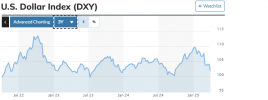I have been here part time since 2007.
I certainly never saw a store without price tags during the Ks, or Alberto, or Macri.
I do have Argentine friends who worked retail in the 70s, who did, indeed, reprice items every single day.
But in 2019- 2022? Sure didnt happen anywhere I shopped.
Certainly there was inflation. But there were also wage increases.
The real figure to study would be the drop in purchasing power, after subtracting wage increases from inflation.
GDP is pretty meaningless, it looks at the aggregate, without dividing the 1% from the rest of us.
Every Argentine I know suffered much more in the last year than in the previous 4.
And the double whammy of rents tripling due to Milei dropping regulations is not caused by either inflation or fore-ex rates.
The dollar index is based on the dollar vs a basket of the Euro, Swiss franc, Japanese yen, Canadian dollar, British pound, and Swedish krona.
Which really doesnt tell you much about who values the argentine peso, who needs it to do business, or who is buying and selling in pesos.
It makes sense that stable economies like Sweden would remain pretty much similar in their relation to the dollar.
So I dont see a lot of value in the dollar index.
I always like the UGI index, myself- the study of the prize of a basic fast food pizza in dollars tells you a lot more than how the dollar is faring against the yen.
I tend to use the choripan index.
When I first arrived, a choripan was 3 pesos, and that was about a dollar.
Current prices in my barrio are around 6000 to 8000 pesos, which is six bucks or so.
In 19 years, thats inflation of 500%.
and 120% of that is Milei...

